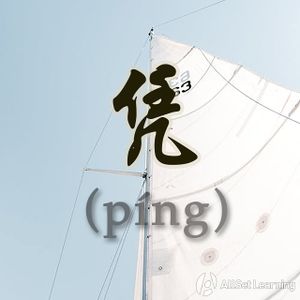Difference between revisions of "Expressing "on the basis of" with "ping""
| Line 35: | Line 35: | ||
<div class="liju"> | <div class="liju"> | ||
| − | * 怪不得 那 个 孩子 的 数学 不 好,他 只 凭 计算器 算。 | + | * 怪不得 那 个 孩子 的 数学 不 好,他 只 <em>凭</em> 计算器 算。 |
* 学好 跳舞 不 能 只 <em>凭</em> 看 迈克尔·杰克逊 的 音乐 录像带, 还 得 凭 自己 的 努力。 | * 学好 跳舞 不 能 只 <em>凭</em> 看 迈克尔·杰克逊 的 音乐 录像带, 还 得 凭 自己 的 努力。 | ||
* 我们 <em>凭</em> 凭 为 他人 做服务 表示 我们 的 关心。 | * 我们 <em>凭</em> 凭 为 他人 做服务 表示 我们 的 关心。 | ||
Revision as of 02:34, 25 February 2013
-
Level
-
Similar to
-
Used for
-
Keywords
凭 is a preposition that means "on the basis of" or "by virtue of". Usually the subject of a sentence with 凭 is a person.
Contents
Structure with 凭
凭 with a noun
凭 can be followed up with a noun or noun phrase. The nouns can be something concrete like 银行卡, 身份证, etc., or they can be something abstract like 经验, 努力, 感觉 etc.
凭 + noun/noun phrase
Examples
- 凭 护照, 外国 人 可以 买 火车 票。
- 他 凭 自己 的 努力 学 了 三千 多 个 汉字。
- 我们 凭 学生证 在 电影院 享受 折扣 优待。
凭 with a verb phrase
凭 can also be used with a verb phrase or subject-predicate phrase,as follows:
凭 + verb phrase/subject-predicate phrase
Examples
- 怪不得 那 个 孩子 的 数学 不 好,他 只 凭 计算器 算。
- 学好 跳舞 不 能 只 凭 看 迈克尔·杰克逊 的 音乐 录像带, 还 得 凭 自己 的 努力。
- 我们 凭 凭 为 他人 做服务 表示 我们 的 关心。
凭 with 什么
This is one of the most common grammatical phrases, heard many times. It often has a feeling of dissatisfaction or anger, perhaps said while people are arguing. It is like saying "On what basis do you ...!?!?" Usually it is paired with blame, scold, hit etc.
Subject + 凭什么 + noun phrase
Examples
- 你 凭什么 怪 我!
- 我 没有 做 错,他 凭什么 骂 我?
- 她 一直 很忠诚, 你 凭什么 怀疑 她?
Structure with 凭着
You can also add 着 to 凭 to make it 凭着, however when you do so you can only use it is the action was completed. If the actions happens frequently or has not happened yet, you cannot use 凭着. The structure is the same as using 凭 by itseld.
凭着 + noun/noun phrase
Examples
- 小白 凭着 自己 的 努力 致富。
- 他 凭着 智慧 战胜 了 很多 的 困难。
See also
Sources and further reading
Books
- Chinese Grammar - Broken down into 100 items - Basic and Intermediate Levels (汉语语法百项讲练 - 初中级) (p. 227-228)
→buy



